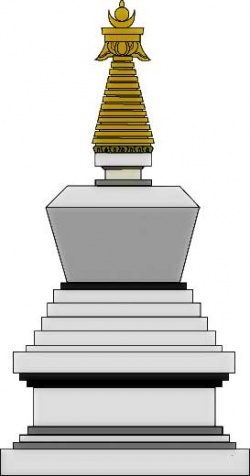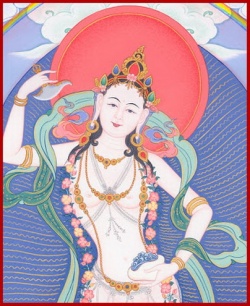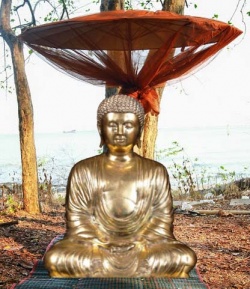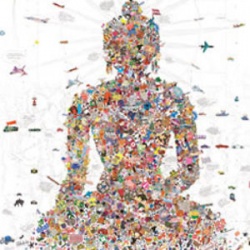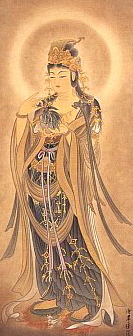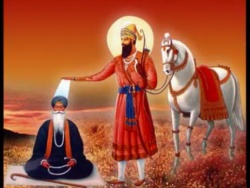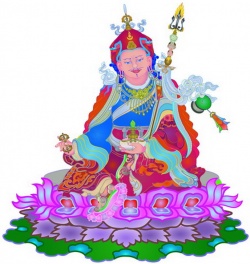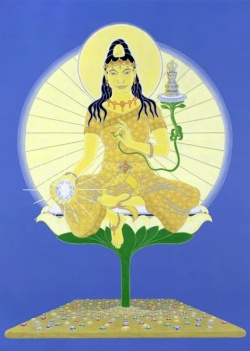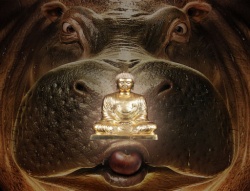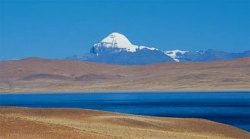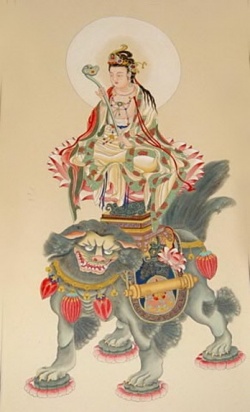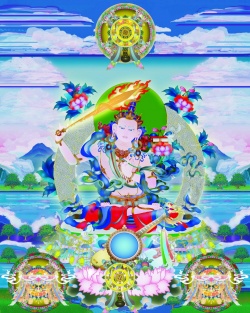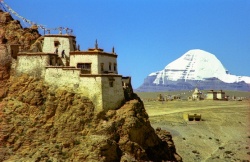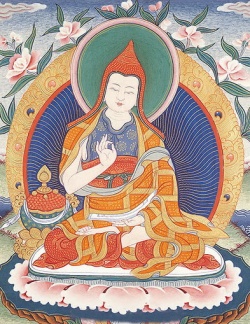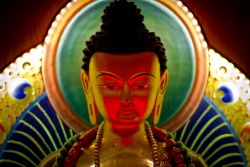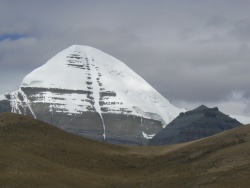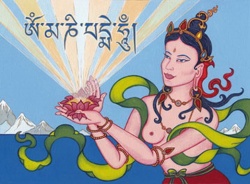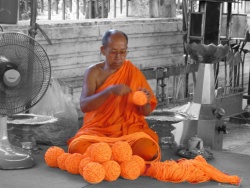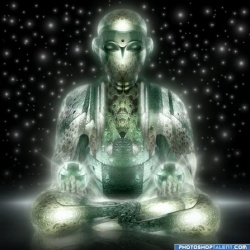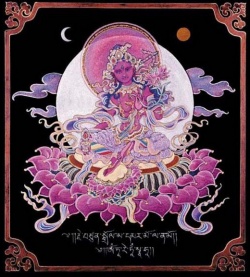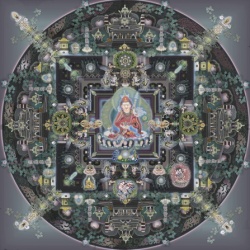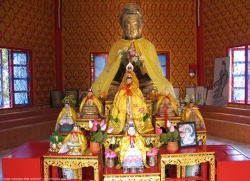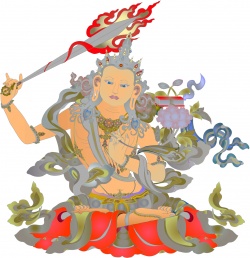Nirvana Sutra: Chapter Forty-Four: On Bodhisattva Kasyapa (e)
Mahayana Mahaparinirvana Sutra
Translated by KOSHO YAMAMOTO
FROM Dharmakshema's Chinese version
The World's genuinely first-ever web edition of this complete scripture
(This "Yamamoto/page edition" is Copyright of Dr. Tony Page, 2004 )
The Complete Kosho Yamamoto English Translation of the "Nirvana Sutra", edited and revised by Dr. Tony Page, typographically improved by Jay and Gabriele Mazo
Chapter Forty-Four: On Bodhisattva Kasyapa (e)
Bodhisattva Kasyapa said to the Buddha: "All beings reap the karmic fruit of defilement. Defilement is evil. The defilement that arises out of evil defilement is (also) evil. If so, there are two kinds. One is the "cause", and the other the "result". As the cause is evil, so the result is evil. As the fruition is evil, the seed is evil. This is as with the nimba fruit. As the seed is bitter, the flower, fruit, stem, and leaves are all bitter. This is as with the seed of a poisonous tree, where as the seed is poisonous, the fruit, too, is poisonous. The cause is the being and the result is the being. The cause is defilement, and the result is also defilement. The cause and the result of defilement are beings, and beings are the cause and result of defilement. If this is indeed the inference, why did the Tathagata employ the parable of the grass in the Himalayas which is poisonous and (also) an all-wonderful medicine”? If we say that defilement is the being and the being defilement, how can we say that there is a wonderful medicine in the body of the being?"
The Buddha said: "Well said, well said, O good man! Innumerable beings have the same doubt. You now do well to ask for an answer. I shall make this point clear too. Listen well, listen well! Think well about this. I shall now clearly state and explain this to you.
"O good man! I speak of the Himalayas in my parable, alluding therein to beings. The poisonous grass refers to defilement, and the all-wonderful medicine refers to pure deeds. O good man! When beings practise such pure deeds, we say that they possess an all-wonderful medicine within."
Bodhisattva Kasyapa said to the Buddha: "O World-Honoured One! How does a being possess pure deeds?"
"O good man! In the world, we see that a seed brings forth fruit. Now, there are cases where this seed, at times, becomes the cause of the fruit. Or there are cases where it does not. It can only be called "seed" and "fruit" when things proceed thus. When things do not proceed thus, we only say "fruit", and not "seed". It is the same with beings. All have two kinds (of deed). With the one, it is the result of defilement, and also the cause of defilement. With the other, it is the fruit of defilement, but not the cause of defilement. When it is the fruit of defilement, but not the cause of defilement, we call this a "pure deed". O good man! Beings meditate on feeling and come to know that this is the near cause of all defilements. Because of feeling, a person cannot cut off all the defilements that are inside and out. All defilements, too, are unable to get out of the prison house of the three worlds. Beings, due to feeling, adhere to self and what belongs to self and gain the inversions of mind, image, and views of life. Hence, beings must first meditate on feeling. Such feeling becomes the near-cause of all phases of craving. For this reason, the wise, when they desire to extirpate craving, must first meditate on feeling.
"O good man! All the good and evil of beings that come forth from the 12 links of interdependence take their rise from feeling. That is why I said to Ananda: "All the good and evil deeds of all beings take their rise at the time of feeling." That is why a person who possesses Wisdom must first meditate on feeling. When this meditation is done, the person then thinks: "Through what causal relations does such a feeling come about? If from causal relations, from what do such causal relations come about? If by non-cause, why is it that such a non-cause does not call forth non-feeling?" He also thinks: "This feeling does not come about through the works of Mahesvara, nor through man, nor by motes, season, image, nature, self, power from without; nor does it come about through the combined working of one's own self and others; nor is it through non-cause. This feeling comes about through combined causal relations. The causal relations are at once craving. It is not that there is craving in this combination, nor is it that there is no craving. It is not that there is no feeling. For this reason, I truly cut off this harmonisation (conjoining). By cutting off this harmonisation, no feeling comes about."
"O good man! The cause (once) thought about, the wise person now meditates on the fruition of karma: "Beings, through feeling, suffer from the innumerable sorrows of hell, hungry pretas, and animals down to the three realms. Because of the causal relations of feeling, there is no Eternal and no Bliss. The person thus extirpates the root of good and through this, the person gains emancipation." When one thus meditates, there exists no cause of feeling.
"How can we say that it does not call forth the cause of feeling? This is the discrimination of feeling. What feeling becomes the cause of craving and what craving is the cause of feeling?
"O good man! As beings thoroughly meditate on the cause of craving, they truly segregate themselves from self and what belongs to self. O good man! If one thoroughly meditates thus, one will indeed come to see where craving and feeling end. That is to say that one sees craving, and feeling goes off somewhat. Know that there ultimately will be an end. Then, one comes to have faith in Emancipation. As one gains faith, one comes to see from where Emancipation arises. One sees that this arises from the Eightfold Right Path, and one learns to practise.
"What is the Eightfold Right Path? In this are the three feelings: 1) suffering, 2) joy, and 3) non-suffering and non-joy. These three increase one's body and mind. Why is there increase? This arises from touch (“sparsa”). Touch has three phases, which are: 1) touch of ignorance, 2) touch of brightness, and 3) touch of non-brightness and non-ignorance. The touch of brightness is the Eightfold Right Path. The other two touches increase body and mind and the three feelings. That is why I say that one must extirpate the two touches. When one extirpates the touch of the causal relations, one no longer gains the three feelings.
"O good man! Such feeling is the cause and also the result. One who is wise must meditate on the cause-result. What is the cause? From feeling one gains craving. This is the cause. What is the result? It arises from touch. Hence, the result. So, this feeling is the cause-result. The wise person thus meditates on feeling and craving. When one harvests the karmic results, this we call craving. A wise person meditates on craving in two ways, namely: 1) mixed eating and 2) non-eating. The craving for mixed eating causes birth, old age, illness, and death, and all other existences. The craving of non-eating cuts off birth, old age, illness, and death, and all other existences, and devours but the undefiled Way. A wise person will think: "Should I gain craving for mixed food, I shall not be able to do away with birth, old age, illness, and death. Though I now devour the undefiled Way, if I do not make away with the cause of feeling, I shall not be able to gain the fruition of the undefiled Way. So I must make away with this touch. Touch once cut off, feeling will die away by itself. Feeling once done away with, craving, too, dies away by itself. This is the Eightfold Right Path."
"O good man! If a person meditates thus, there can be the all-wonderful medicine in the body of poison, just as in the Himalayas there is the all-wonderful medicineal herb, although there is also poisonous grass, too. O good man! One thus receives a karmic result through defilement. But this karmic result does not further become a cause of (subsequent) defilement. This is pure action.
"Also, next, O good man! A wise person meditates and reflects on why the pair, feeling and touch, come about, and he sees that they come about through image. How? Beings see material form and do not gain desire. And also at the time of feeling, no desire comes about. If one should gain an inverted image regarding material form and say that material form is the Eternal, Bliss, Self, and the Pure, and that there can be no change, one, through this inversion, will gain greed, ill-will, and ignorance. So the wise must meditate on image.
"How does one mediate on image? One should think that all beings have not yet gained the Right Way and that they all have inverted images. What is an inverted image? Being in what is not Eternal, a person has an image of (i.e. sees this as) the Eternal; in non-Bliss, a person has an image of Bliss; being in what is not Pure, he has an image of what is Pure; being in what is empty, he has an image of the Self; being in what is not man or female, big or small, day or night, month or year, clothing, house, or bedding, he has images of man and female, down to bedding.
"Of this image, there are three kinds, namely: 1) small, 2) big, and 3) boundless. Through a small causal relation, one gains a small image; through a big causal relation, one gains a big image; through an unbounded causal relation, one gains an unlimited image. Also, there is a small image, which refers to one who has not yet gained samadhi. Also, there is a big image, which relates to one who has already gained samadhi. Also, there is an (unbounded) image, which relates to the ten reciprocal all-enterings (“dasa-krtsnayatana”). Also, there is a small image, which relates to all the images of the world of desire. Also, there is a big image, which corresponds to all the images of the world of form. Also, there is an unbounded number of images, which refers to all the images of the world of formlessness. When the three phases of image die away, feeling by itself dies away. When the image and feeling go away, we say "Emancipation".
Bodhisattva Kasyapa said: "O World-Honoured One! When all phases of things die away, we gain Emancipation. Why do you, Tathagata, say that the extinction of image and feeling is Emancipation?"
The Buddha said: "O good man! The Tathagata, at times, speaks by the being, at which the one listening understands the thing; or, at times, he stands on the thing about the being , and the one listening understands what is said about the being.
"What do I mean by saying that when I speak of the being, the person who is listening takes it to refer to a thing? This is as when I once said to Mahakasyapa: "O Kasyapa! When the being dies, Wonderful Dharma dies out too." This is what I mean when I say that when I speak standing on the being, the one listening takes it to refer to a thing. What do I mean by saying that when I speak, standing on dharma, about the being, the listener takes it to have been said about the being? This is as I once said to Ananda: "I do not say that I befriend all things or that I do not. If I befriend the law (Dharma), the good law (Wonderful Dharma) will weaken and the non-good will become luxuriant. One must not befriend such a law. If one befriends the law, the non-good will weaken and the good law augment. One should come near such a law." This is what I say, standing on a thing, about the being, and the one listening takes it as my speaking about a being.
"O good man! The Tathagata speaks about the two extinctions of image and feeling. But he has already spoken about all that could be extirpated. When a wise person has meditated on such an image, he must next meditate on the cause of the image.
"How do all the innumerable images come about? One comes to know that they come about from touch. And this touch is of two kinds, namely: 1) touch by defilement and 2) touch by Emancipation. If it arises out of ignorance, we call this "touch by defilement". What comes about from "brightness" is called "touch from Emancipation". The touch from ignorance calls forth an inverted image, and that from Emancipation calls forth a non-inverted image. When one has meditated on the cause of the image, one next meditates on the karmic result."
Bodhisattva Kasyapa said to the Buddha: "The inverted image comes about from the image of defilement. All holy persons, truth to tell, possess inverted images and yet possess no defilement. How am I to understand this?"
The Buddha said: "O good man! In what way does a holy person possess an unverted image?"
Bodhisattva Kasyapa said: "O World-Honoured One! All holy ones, on seeing a cow, gain the image of a cow and say that this is a cow. Seeing a horse, they gain the image of a horse and say that this is a horse. The same applies to man, woman, big and small, house, vehicle, going and coming. This is an inversion."
"O good man! All beings possess two kinds of image, namely: 1) the image current in the world and 2) the image from clinging. All holy people have only the image current in the world, but do not have any image from clinging. All beings gain the image of clinging, because of the meditation by evil sensing. All holy persons do not gain the image of clinging, because of (their) awakening to good. Hence, all common mortals are classed as of the inverted, whereas the holy persons are not so classed, though they may know.
"Having meditated on the cause of the image, a person who is wise next meditates on the karmic results. One suffers such karmic results of the evil image in the realms of hell, hungry ghosts, and animals, and of humans and gods. As I have done away with the image of evil awakening, I have cut off ignorance and touch. So does the image go. When the image is done away with, the person also removes the karmic consequences. To cut off the cause of the image, the wise person practises the Eightfold Right Path. O good man! Any person who thus meditates is called one who practises pure deeds.
"O good man! Thus do I say: "In the poisonous body of the being there is an all-wonderful medicine. Though in the Himalayas there is a poisonous (type of) grass, there is (also) an all-wonderful medicine."
Also, next, O good man! One who is wise meditates on desire. Desire is colour, sound, smell, taste, and touch. O good man! Thus the Tathagata speaks of the result in the stage of cause. From these five things, desire raises its head. And it is no desire.
"O good man! A person who is ignorant greedily seeks to partake of these. In these material forms, the person gains an inverted image. And this gaining of an inverted image extends down to "touch". And from the causal relation of inversion, there arises feeling. That is why I say that from this inverted image the world gains the ten images.
"From the causal relation of desire, one harvests evil karmic consequences in the world. The evil is directed to parents, sramanas, and Brahmins. One does what one ought not to do, and one does this wilfully, head and foot. Thus, a person who is wise realises the fact that this causal relation of evil evokes a covetous mind. Having thus realised the cause of evil, the wise person first meditates on the cause of covetousness and then thinks about the karmic results. When there is much desire, there come forth many evil results, such as (the realms of) hell, hungry ghosts, animals, humans and gods. This is what we call realising evil results.
"If one is able to do away with the evil image, no mind of covetousness will arise. When there is no covetous mind, there arises no evil feeling. With no evil feeling, there cannot be any evil result. That is why I first do away with the evil image. The image of evil once done away with, things as such naturally die away. Hence, the wise person practises the Eightfold Right Path, in order to do away with the evil image. This is what we call "pure action". This is why we say that in the poisonous body of the being, there is an all-wonderful medicine, as in the case of the Himalayas, where, though there are poisonous grasses, there is an all-wonderful medicine, too.
"Also, next, O good man! Having meditated thoroughly in this way on desire, the wise person next meditates on karma. Why? The wise person thinks: "Feeling, image, touch, and desire are defilements. Defilement truly brings forth living karma, but not harvesting karma. Such a defilement goes along with karma and is made up of two kinds: 1) living karma and 2) harvesting karma. Hence, the wise person must meditate well on karma. This karma is of three kinds: body, mouth, and mind." O good man! The pair, body and mouth, are also called karma and also the karmic result. The mind is called merely "karma", and not "result". As it is the cause of karma, we say "karma". O good man! We call the karmas of body and mouth the external karma, and the mental karma the internal. These three karmas go together with defilement. So we have two karmas, namely: 1) living karma and 2) feeling karma.
"O good man! "Right karma" is mental karma. We say "temporal karma". This refers to the karmas of body and mind. Being what appears first, we say "mental karma". What arise from the mental are the bodily and oral karmas. So, what is mental is called "right". Having meditated on karma, a wise person must meditate on the cause of karma. The cause of karma is the touch of ignorance. Due to the touch of ignorance, beings see "existence". The causal relation of existence is "craving". Due to the causal relation of craving, a person performs the three actions of body, mouth, and mind.
"O good man! Having meditated on the cause of karma, the wise person meditates on the karmic result. There are four kinds of karmic result, namely: 1) black-black karmic result, 2) white-white karmic result, 3) mixed-mixed karmic result, and 4) non-black-non-white-non-black-non-white karmic result.
"The black-black karmic result is such that it is defiled at the time of the action and the karmic result, too, is defiled. We say white-white karmic result, which is pure when (the deed is) being enacted, and the karmic result too is pure. We speak of a mixed-mixed karmic result, which is one (of a) mixed (nature) during (the deed's) enactment, and the karma, too, is mixed. We say non-white-non-black-non-white-non-black karmic result. This is undefiled karma."
Bodhisattva Kasyapa said to the Buddha: "O World-Honoured One! You said before that the undefiled has no karmic result. Why do you now speak about the non-white-non-black of the karmic result?"
The Buddha said: "O good man! There are two meanings to this. One is the result and the recompense put together, and the second is the fruition, but not the recompense. The black-black karmic result is the result, and also the recompense. When it arises out of a black cause, it is a "result"; when it becomes a cause, we say "recompense". It is the same with the pure and the mixed. The undefiled result comes out of a defiled cause. Hence, "result". When it does not become the cause of any other thing, we do not say "recompense".
Bodhisattva Kasyapa said to the Buddha: "O World-Honoured One! This undefiled karma is not that which is black. Why do you not call it white?"
"O good man! As there is no recompense, I do not call it white. When a cure is caused to the black, I say white. I now say: "What receives the karmic result is called black or white. As this undefiled action does not harvest any recompense, I do not call it white. I say "quietude". All such actions are definitely subject to recompense. The ten evil things are definitely subject to the realms of hell, hungry pretas, and animals. The ten good things definitely gain (one) the world of humans and gods. In the ten good things, we have the grades of: top, middle, low. Through the top causal relation, one gains hell, through the middle causal relation the animal (realm), and through the low, life in hell. Also, of a human's ten good deeds there are four kinds, namely: 1) low, 2) middle, 3) top, and 4) topmost. Through the low causal relation, one gains life in Uttarakuru; through that of the middle, Purvavideha; through the top causal relation, Godaniya; and through the topmost causal relation, life in Jambudvipa.
"When this meditation is performed, the wise man thinks: "How am I to segregate myself from this karmic result?" He also thinks: "This causal relation arises out of ignorance and touch. If I do away with ignorance and touch, such a karmic result will die out and not come about. Hence, a person who is wise, in order to extirpate the causal relations of ignorance and touch, must practise the Eightfold Right Path. This is pure action." O good man! This is why I say that in the poisonous body of the being there is an all-wonderful medicine. This is as in the instance of the Himalayas, where, though there are poisonous herbs, there is a medicinal herb, too.
"Also, next, O good man! Having meditated on karma and defilement, a wise man then meditates on the two karmic results that have been attained. These two karmic results are of suffering. When this suffering is known, one segregates one's self from all beings. The wise person also thinks: "The causal relation of defilement also calls forth defilement. Being the causal relation of karma, it again calls forth defilement. The causal relation of defilement again calls forth karma. The causal relation of karma calls forth suffering, and from the causal relation of suffering comes about defilement. The causal relation of defilement calls forth existence, and the causal relation of existence calls forth suffering. The causal relation of existence calls forth existence. The causal relation of existence calls forth karma, and the causal relation of karma calls forth defilement. The causal relation of defilement calls forth suffering. The causal relation of suffering calls forth suffering."
"O good man! If any wise person thus meditates thoroughly, one should know that such a person truly meditates on the suffering of karma. Why? All that is stated above referring to meditation are the causal relations of birth and death of the 12 links of interdependent arising. If a person thus thinks thoroughly about the 12 links of interdependence, one may know that this person no longer creates any new karmas and thoroughly crushes out old sufferings.
"O good man! A person who has Wisdom meditates on the suffering of hell. From one hell to 136 places, each hell has various types of suffering. All arise out of the causal relations of the karma of defilement. Thus does one meditate. When the meditation on hell has been completed, this leads to the meditation on the sufferings of the hungry pretas and animals. Having done this meditation, one again thinks of all the sufferings of humans and gods. All such sufferings arise from the karmas of defilement.
"O good man! In the life of heaven, we do not have any of this kind of great suffering. The body is soft, delicate and smooth. (But) when one sees the five forebodings of decline, great suffering raises its head. It is as with the suffering of hell, which proceeds in the same way, all equally.
"O good man! The wise meditate and think that all the sufferings of the three worlds take their rise from the causal relations of defilement. O good man! For example, a tile that has not yet been passed through heat is easy to break. It is the same with the physical body of a being, too. Gaining the body, this is now a vessel of suffering. For example, the luxuriance of the flowers and fruit of a big tree gets destroyed by birds; and piles of dried grass can easily be burnt up by a small bit of fire. It is the same with the fleshly body of the being, which easily breaks up.
"O good man! If a wise person can meditate well on the eight sufferings as in holy actions , know that this person indeed segregates himself from all sufferings.
"O good man! A wise person deeply meditates on the eight sufferings, and next on the cause of suffering. The cause of suffering is the ignorance of craving, which is made up of two things: 1) seeking what is bodily and 2) seeking wealth. Seeking what is bodily and seeking wealth are both sources of suffering. So one must know that the ignorance of craving is the cause of suffering.
"O good man! There are two kinds of this ignorance of craving, namely: 1) inner and 2) outer. That which is inner truly moulds karma, whereas what is external augments it. Also, that which is internal indeed moulds karma, and what is external moulds the karmic result. If internal craving is done away with, karma can indeed be done away with. If external craving is cut off, the karmic fruit goes away. Internal craving moulds the suffering of the world that is to come, whereas external craving calls forth the suffering of the present life. The wise meditate on the cause of suffering, which is craving. Having meditated on the cause, they do so on the karmic result. The karmic result of suffering is "cleaving" (“upadana” - clinging to existence). The result of craving is cleaving. The karmic result of craving is cleaving. The causal relation of this cleaving, which is inner and outer craving, calls forth the suffering of craving.
"O good man! The wise must meditate and think that craving is causally related to cleaving, and cleaving is causally related to craving. If one truly extirpates this pair, craving and cleaving, there will be no more karmic action; one will no more suffer from any kind of sorrow. Hence, the wise should practise well the Eightfold Right Path and make away with all sufferings.
"O good man! If any person meditates thus, this is pure action. This is where we say that beings possess an all-wonderful medicine in their carnal poisonous body and that in the Himalayas, amidst the poisonous grass, there is an all-wonderful medicinal herb."
Bodhisattva Kasyapa said to the Buddha: "O World-Honoured One! What is pure action?"
The Buddha said: "All things are nothing but pure action."
Bodhisattva Kasyapa said: "O World-Honoured One! All things are not fixed in meaning. Why? The Tathagata calls them either good or non-good. At times, he says that such is the meditation of the four remembrances, or at times, the 12 spheres, or the good teacher of the Way, or the 12 links of interdependence, or the being, right view, wrong view, the 12 types of sutra, or the two truths; or the Tathagata now says that all things are pure actions. All in all, what do you mean by "all things"?
The Buddha said: "Well said, well said, O good man! The all-wonderful Great Nirvana Sutra is the treasure-house of all dharmas. It is like the great sea, which stores up all treasures. It is the same with this Nirvana Sutra. This is the secret house which contains all the meanings of all words.
"O good man! Just as Mount Sumeru is the root source of all medicines, so is this sutra the root source of the Bodhisattva precepts.
"O good man! It is as with the Void, wherein rests all that exists. So is it with this sutra, which is the abode of Good Dharma.
"O good man! It is like the great wind, which no one can bind or check. So is it with all Bodhisattvas who practise this sutra. No defilement or evil teaching can check or bind (them).
"O good man! It is like the diamond, which no one can destroy. So do matters stand with this sutra, which no tirthikas or men of evil notions can destroy.
"O good man! It is like the sand of the river Ganges, which no one can count. So is it with the meaning of this sutra. No one can truly count it out to completion.
"O good man! This sutra is the banner of the Dharma of all Buddhas, just as things so obtain with the hanging ensigns of Sakra.
"O good man! This sutra is the merchant that journeys nirvana-wards, or the great guide that takes to the great sea with all merchants.
"O good man! This sutra is the light of the Dharma of all Bodhisattvas, just as the light of the sun and moon truly destroy the gloom all round.
"O good man! This sutra serves as the best (medicine) to all beings who are suffering from illness. It is like the all-wonderful king of medicine of Gandhamadana, which thoroughly cures all illnesses.
"O good man! This sutra truly serves as a staff to the icchantika, as in the case of a weak person who can (thereby) easily support himself and stand up.
"O good man! This sutra truly serves as a bridge to all evil persons, just as a bridge even allows all the evil persons of the world to pass (over it).
"O good man! This sutra truly serves as a cool shade to all those who carry on their life in the five realms, where they feel hot due to the heat of defilement, serving (them) like a parasol that protects a person well from the heat.
"O good man! This sutra is the king of fearlessness, which thoroughly crushes out all the devils of defilement, acting like the lion king, who truly subdues all beasts.
"O good man! This sutra is a great charmer that can thoroughly crush out all the devils of defilement, just as a charmer makes away with the mountain elf.
"O good man! This sutra is like the unsurpassed frost and hail that crush out all the karmic results of birth and death, just as the hail destroys the fruit trees.
"O good man! This sutra is the greatest of medicines to a person who violates sila (the moral precepts), just as the ajata can truly cure pain of the eyes.
"O good man! This sutra houses all good dharmas, just like the earth, which serves as the support for all things.
"O good man! This sutra is a bright mirror to all beings who violate the precepts, just like a mirror which reflects well all colours and forms.
"O good man! This sutra serves as clothing for those who do not feel ashamed of what they do, just like clothing that can well cover and hide the carnal form.
"O good man! This sutra serves as a great treasure-house to those who are lacking in good things, just as Gunadevi gives benefit to the poor man.
"O good man! This sutra serves as the water of amrta (Immortality) for those who thirst for Dharma, just like the water of the eight tastes, which thoroughly satisfies a thirsty man.
"O good man! This sutra serves as a bed of Dharma to those who have the worries of defilement, just like the bed of peace that serves the people of the world.
"O good man! By means of this sutra, the Bodhisattva rises from the first stage up to the tenth. It is the cart upon which are laden jewellery, incense, flowers, and all such incense as pasting, powdery, and burning incense, and the cart in which those of pure castes can ride. It truly supercedes (surpasses) the six paramitas. This is a wonderful land of bliss. It is like the parijata tree of Trayastrimsa Heaven.
"O good man! This sutra is an adamantine and sharpened hatchet which can indeed fell the great tree of all defilements. This is the sharpened sword that can truly make away with the taint of ill smell. This is the valiant and strong that can thoroughly crush out the adversity (opposition) of Mara. This is the fire of Wisdom, which burns up the fuel of defilement. This is the storehouse of causal relations which gives birth to the pratyekabuddha. This is the storehouse of hearing which gives birth to the sravakas. This is the eye of all gods that serves as the Right Path to all beings. This is a refuge to all animals. This is where the hungry ghosts gain Emancipation, the most holy of hell, and the unsurpassed utensil for all beings of the ten directions. This is the parent of all Buddhas of the ten directions of past, future, and present. O good man! Thus, this sutra holds within itself all dharmas."
(The Buddha said:) "As I have already said, this sutra embraces all dharmas. But I have stated that the pure actions about which I speak are none other than the 37 elements assisting towards Bodhi (Enlightenment). O good man! Separated from the 37 elements of Enlightenment, one cannot attain the fruition of sravaka practice and unsurpassed Enlightenment, and one cannot see the Buddha-Nature, nor the fruition that arises from the Buddha-Nature. This being so, pure action is the 37 Bodhi elements (“bodhipakshikadharma” - the 37 prerequisites for attaining Enlightenment; they include mindfulness, and the Noble Eightfold Path). How can we say this? Because the 37 elements assisting towards Enlightenment are those factors which, by nature, are not inverted and indeed crush out the inversions. They are, by nature, not evil views, and can truly crush out evil views. They are, by nature, not fears, and they well crush out fear. They are, by nature, pure actions, so that beings ultimately perform pure actions."
Bodhisattva Kasyapa said to the Buddha: "O World-Honoured One! Even the defiled can also become a cause of the non-defiled. Why is it that the Tathagata does not say that the defiled, too, is pure action?"
"O good man! All defiled things are nothing but inversions (of Truth). That is why I cannot claim the defiled to be pure action."
Bodhisattva Kasyapa said to the Buddha: "Is the first-of-the world root of good (“laukikagradharma” - intellectual penetration and insight) that which is defiled or non-defiled?"
The Buddha said: "It is that which is defiled."
"O World-Honoured One! Though defiled, its nature is not inverted. Why do you not call it pure action?"
"O good man! The first-of-the-world root of good is the cause of the defiled. So it well resembles it. As it faces the undefiled, we do not call it any inversion. O good man! Pure action takes its rise from the stage of taking one's aspiration (to Buddhahood). It goes thus and attains the uttermost. The first-of-the-world root of good is none but one mind. That is why we cannot call it pure action."
Bodhisattva Kasyapa said to the Buddha: "O World-Honoured One! The five consciousnesses of the being are the defiled, and yet not inversions. Nor are they of one mind. Why do we not say pure actions?"
"O good man! The five consciousnesses of the being are not of one mind. They are the defiled and inversions. As defilements increase, we say "defiled". The body is not of true stuff. Due to clinging and the image, they are inversions. Why do we say that the body is not true? Because of clinging and image. Where there is no man or woman, they gain the image of man or woman. So does it go with house, vehicle, pot, clothing, etc. This is an inversion.
"O good man! With the 37 factors of Enlightenment, there is no inversion. So we can speak of "pure action". O good man! If any Bodhisattva comes to know of the root, cause, what takes in, what augments, the master, what leads, what is superior, what is true, and the ultimate, such a Bodhisattva is one of pure action."
Bodhisattva Kasyapa said to the Buddha: "O World-Honoured One! In what sense do we say that one knows the root up to the ultimate?"
The Buddha said: "O good man! Well said, well said! What you, Bodhisattva, speak about concerns two things. One is for your own good, and the other is for knowing by others. You now know, but since innumerable beings do not yet understand, you ask. So I now praise you once again. It is good, it is good. O good man! The root of the 37 elements assisting towards Enlightenment is desire. The cause is the touch of brightness; that which takes in is "feeling"; that which augments is "thinking"; the "master" is "remembrance"; that which leads is dhyana (meditation); that which is superior is Wisdom; that which is true is Emancipation; and the ultimate is Great Nirvana.
"O good man! All the worries of the world take their rise from craving. All illnesses rest on the food cooked on the preceding day. All segregation arises out of quarrelling and disputation. All evils arise out of falsehood. The situation is thus."
Bodhisattva Kasyapa said: "O World-Honoured One! The Tathagata has already in this sutra stated that all good things are grounded on non-indolence. You now say "desire". How am I to understand this?"
The Buddha said: "O good man! If the cause is sought relating to (a good thing's) coming about, it is good desire. If the revealing cause (Jap. “ryoin”: the cause that reveals what is hidden, like, for example, lamplight that shines and shows what lies hidden when it is dark - K. Yamamoto) is sought, this is non-indolence. We say in the world that the result depends on the seed; and we say that the seed is the cause of the coming about, and the soil is the revealing cause. The same is the case here too."
Bodhisattva Kasyapa said: "O World-Honoured One! The Tathagata says in other sutras that the 37 Enlightenment factors constitute the base. What does this imply?"
"O good man! The Tathagata said before that beings first come to know of the 37 factors of Enlightenment. The Buddha is the root. To awaken depends on desire."
The "Nirvana Sutra" Continued (Z13)
"O World-Honoured One! What do you mean when you say that "bright touch" is the cause?"
"O good man! The Tathagata at times speaks about brightness and says that it is Wisdom; and at time he says "faith". O good man! Through the causal relation of faith, one draws near to a good teacher of the Way. This is touch (contact). The causal relation of befriending leads the person to give ear to Wonderful Dharma. This is "touch". When one listens to Wonderful Dharma, one's body, mouth and mind become pure. This is "touch". Through the purity of the three actions, one gains right living. This is touch. Through right living, one gains the sila that purifies the sense-organs. On account of the sila that purifies the sense-organs, one comes to seek a silent place. In quietude, one thinks of good. By good thinking, one thinks of a life that accords with Dharma. Through right living, one gains the 37 elements of Enlightenment. And one thoroughly crushes out innumerable evil defilements.
"O good man! Feeling is called "taking-in". Beings do good or evil at the stage of feeling. Hence, we say that feeling is the taking-in. O good man! Through the causal relation of feeling, all kinds of defilements come about. The 37 Bodhi elements truly crush these out. Because of this, we call feeling the taking-in. Good thinking well crushes out the defilements. Hence we speak of "augmenting". Why? We make effort and try to learn. And we arrive at these 37 elements of Enlightenment. Meditation truly destroys evil defilements. This always is grounded on exclusive mindfulness. So, to think is the master. In the world, all the four armies move at the will of the head general. It is the same with the 37 elements of Enlightenment. All follow the will of the master, which is the mind.
"When one enters dhyana (meditation), the 37 elements of Enlightenment well discriminate all phases of dharma. Hence, meditation is what leads one. We look into the 37 elements of Enlightenment and see that Wisdom is the most superior. Because of this, Wisdom is the most superior. That is why Wisdom is made (stated to be) superior. Thus, Wisdom sees defilement. Through the power of Wisdom, defilement dies.
"In the world, the four armies crush out the enemy. There may well be one or two who are valiant and strong and that do well. So is it with the 37 elements assisting towards Enlightenment. Through the power of Wisdom, defilement is done away with. Hence, Wisdom is that which is superior.
"O good man! By learning and practising the 37 elements of Enlightenment, one gains the four dhyanas, the miraculous divine powers, and peace. But this is not called "real". When defilement is done away with and Emancipation is reached, we say "real". A person may aspire to learn and practise the 37 elements of Enlightenment and be blessed with worldly bliss, supramundane bliss, the fruition of sramana practice, and Emancipation. Yet, we cannot call this the "Ultimate". When all the practices of the 37 elements of Enlightenment have been done away with, this is Nirvana. That is why I say that the Ultimate is Great Nirvana."
"Also, next, O good man! The good-loving mind is desire. Through the good-loving mind, a person associates with a good friend. Hence, "touch". This is "cause". When a person associates with a good friend, we call this love. This is a taking-in. Befriending a good teacher, that person thinks well. Hence, "to augment". Through four dharmas is the Way well augmented, namely: 1) desire, 2) remembrance, 3) meditation, and 4) Wisdom. This is: 1) master, 2) leading, and 3) superior. Through these three dharmas, the person attains three Emancipations. Cutting off craving, he attains Emancipation of mind. Doing away with ignorance, he attains Emancipation of Wisdom. This is the Real. All such dharmas result in fruition. This is Nirvana. Hence, the "Ultimate".
"Also, next, O good man! "Desire" is aspring and renouncing. Touch is the four jnapti-caturtha-karman (one of the rituals in the vinaya = monks' code of monastic living). This is the cause. Taking-in means receiving the two kinds of precept, namely: 1) pratimoksa and 2) sila that purifies the sense-organs. This is "feeling" and also "taking-in". To augment means to learn and practise the four dhyanas. The Master refers to the fruitions of srotapanna and sakrdagamin. To lead refers to the fruition of the anagamin; "superior", to that of arhatship. The Real refers to the fruition of the pratyekabuddha; the "Ultimate" is unsurpassed Enlightenment.
"Also, next, O good man! "Desire" is consciousness. Touch is called the six (sensual) spheres. Taking-in is feeling. Augmenting is ignorance. The master is mind-and-body. To lead in is craving. The superior is cleaving. The real is existence. The ultimate is birth, old-age, illness, and death."
Bodhisattva Kasyapa said: "O World-Honoured One! What difference is there between the three items of: 1) root, 2) cause, and 3) augmentation?"
"O good man! The root referred to is that which is to take rise; the cause is that which resembles; augmentation is cutting off resemblance, and yet, calling forth resemblance. Also, next, O good man! The root is to do, the cause fruition, and augmentation is the use. O good man! The world that is to come sees the karmic results. But not yet receiving (them), we call this "cause". When received, that is augmentation. Also, next, O good man! The root is to seek; to gain is the cause, and the use is to augment. O good man! The root spoken of in this sutra is darsanamarga (the path of seeing, leading the person from mere blind trust in the Four Noble Truths to actual comprehension of them, transforming him or her into a "stream-enterer"), the cause is bhavanamarga (the path of self-development through meditation), and to augment is asaiksamarga. Also, next, O good man! The root is the right cause and the cause is the expedient cause. From this right cause comes about the karmic result which one harvests. This is to augment."
Bodhisattva Kasyapa said: "O World-Honoured One! If things are as you the Buddha state, the Ultimate is no less than Nirvana. How can one reach this Nirvana?"
"O good man! If the Bodhisattva, bhiksu, bhiksuni, upasaka, or upasika practises well the ten images, know that such a person will well attain Nirvana. What are these ten? They are the images of: 1) non-eternal, 2) suffering, 3) non-Self, 4) abhorring food, 5) the world as having nothing in it to enjoy, 6) death, 7) one's having many sins, 8) parting from (the worldly) and emancipating (oneself), 9) extinction (of defilement), 10) non-craving.
"O good man! If any Bodhisattva-mahasattva, bhiksu, bhiksuni, upasaka or upasika practise these ten images, such a person will definitely attain Nirvana. Such a person will not follow what other minds think, but will discriminate the good and the non-good for himself. This is what we call: "Truly according with the Way of a bhiksu (monk) or according with the Way of a bhiksuni (nun) ".
Bodhisattva Kasyapa said: "O World-Honoured One! How do those from Bodhisattva-mahasattva down to upasika practise the image of the non-eternal?"
"O good man! There are two kinds of Bodhisattva, namely: 1) the one who has first aspired to and 2) the one who has finished the practice of the Way. There are two kinds of image of the non-eternal, namely: 1) coarse and 2) fine. The Bodhisattva who has first aspired to Bodhi, when he meditates on the image of the non-eternal, thinks: "There are two kinds of thing which obtain in the world: 1) inner and 2) outer. What is within is non-eternal and changes. When I get born, I see that things obtain differently at such times of life as when I am small, big, in the prime of life, in old-age, and when dying, and I see that at all such times of life, things are not the same. Hence, I have to know that what is with me is non-eternal."
"Also, this thought comes to him: "When I look at beings, one is (i.e. I see one person who is) well nourished and fresh, and is perfect in physical strength and in the movements of going and coming, in stepping forward or stopping; and things all proceed unimpededy and without hindrance. Or through illness, (another) person's physical strength is weak and his face fallen and haggered, with nothing of freedom. Or I see that a person's storehouse is full, or that another person is poverty-stricken. Or I see one who is full of all virtues, or I see one full of evil. Thus I definitely know that what is within one is non-eternal. Also, as regards the external world, too, I see things are different one from the other, as, for example, at the times of seed, bud, stem, leaf, flower, and fruit. All that stands (there) in the external world is either perfect or not perfect. And I know that all things are definitely non-eternal."
"Having thus seen that things are all non-eternal, one next meditates on what one listens to sermons. "I hear that though the devas (gods, heavenly beings) fully enjoy the best of pleasures, and though they are unimpeded in divine powers, they are subject to the five declining forebodings (intimations of their eventual personal decline from the status of being devas). Due to this, one knows that what there is is non-eternal."
"Also, I hear that at the beginning of the kalpa (aeon, age), there were many beings. Each was garbed in the best of virtues. The light that shone from their bodies was so great that one did not need any more to depend upon the light of the sun and moon. (But) due to the power of the non-eternal, the light waned and the virtues lessened. Also, I hear that there lived, in days gone by, a Chakravartin (world emperor) who ruled over the four lands. The seven gems (which he possessed) were perfect, and his power was greatly unconstrained. And yet he could not beat the non-eternal."
"Also, he meditates that on the great earth, at one time in the past, innumerable beings were fully stationed in life and enjoyed peace, so that no furrows of the wheel sat one upon the other. Wonderful medicines were ready at hand, and people grew up. Bushes, trees and fruits were full-grown. The beings were (gradually) less blessed and this great earth had little strength. Whatever grew had to waste away. Hence, one can know that all things are non-eternal. That is what we call "coarse" and non-eternal.
"The coarse having been meditated upon, the detailed parts are next meditated upon. How do we meditate? The Bodhisattva-mahasattva meditates on all things, both within and without, down to mote existences. Whatever might come about in the future will be non-eternal. Why? Because all things are perfect in the forms of breaking (i.e. are fully subject to dissolution). If things were not non-eternal in the future, we could not say that there are the differences of the ten kinds of physical form. What are the ten? They are at the times: 1) membrane, 2) foam, 3) pox, 4) ball of flesh, 5) limbs, 6) small infant, 7) child, 8) boyhood, 9) prime of life, 10) tottering old age. The Bodhisattva meditates: "If the membrane is not non-eternal, it cannot become foam. And if the prime of life were not non-eternal, it could never reach old age. If time were not fleeting by, moment after moment, it could never last long. All would have to grow up at one and the same time and be full in size. Hence, one must definitely know that there are the fine, non-eternal mote existences that have to go on existing thus continuously (i.e. changing from moment to moment)."
"Also, we see a person with all his sense-organs perfect, and of a bright and shining mien, (only for) all this to fade away into a weakened state.
"Also, he thinks: "There is with this person the non-eternal (i.e. that which is impermanent) going on moment after moment." Also, he meditates on the four great elements and the four deportments. Also, he meditates on the cause of suffering, hunger, and thirst, the cold and heat that exist within and without. Also, he meditates: "If these four things were not non-eternal moment after moment, we could not speak of such four sufferings." If the Bodhisattva well meditates thus, we call this the Bodhisattva's meditating minutely upon the non-eternal."
(The Buddha said:) "As with all things that exist within and without, so does it go with what obtains in the mind. Why? Because action obtains in the six spheres. When this obtains in the six spheres, there comes about the happy mind, the angry mind, the craving mind, or the greedy mind. Life goes differently one after the other, and cannot be one. For this reason, one has to know that all that is physical and non-physical is non-eternal.
"O good man! If the Bodhisattva can, in the flash of a moment, see the birth and death and non-eternality of all things, this is what we call the Bodhisattva's being perfect in the image of the non-eternal. O good man! The wise man learns and practises the image of the non-eternal, and makes away with the arrogance of the eternal, the inversion (i.e. wrong-headed view) of the eternal, and the inversion of the image.
"Next, he practises the image of suffering. Why should there be such suffering? He sees that this suffering is grounded on the non-eternal, that because of the non-eternal, there is the suffering of birth, old age, illness, and death, that because of birth, ageing, illness, and death, there is the non-eternal, that because of the non-eternal, there is internal and external suffering, and such suffering as (that from) hunger, thirst, cold, heat, whipping, beating, abusing, and endurance. He sees that all suffering is based on the non-eternal.
"Also, next, the wise man looks deeply into this fleshly body and sees that it is a vessel of the non-eternal, and that this vessel is suffering. And as the vessel is suffering, the things that are put into it are suffering.
"O good man! The wise person meditates (thus): "Suffering is non-eternal. If suffering is non-eternal, how can the wise say that there is the Self (there)? Suffering is not the Self. The same is the case with the non-eternal (i.e. that which is impermanent is not the Self). Thus, the five skandhas are also the non-eternal of suffering. How could all beings say that there is the Self (there)?"
"Also, next, he meditates on all things (thus): "There is a conjoining of what is different. All things do not come about from a single conjoining. Also, one thing is not the result of the conjoining of all things. The conjoining of all things does not have a Self of its own. Also, there is no single nature and no different natures. Also, there is no nature of material form, and no unmolestedness (freedom to do as one wills; unobstructedness). If all things possess these aspects of existence, how can the wise say that here is the Self?"
"Also, he thinks: "Of all things, there is not one thing that is done by the creator of its own (i.e. nothing creates itself). If there is not one thing that has that which creates it, the conjoining of all things also cannot come about. All things cannot come about alone and die out alone. Through (the act of) conjoining, they die, and through conjoining, they come about.
"When things have come about, beings gain an inverted (view) and say that this is conjoining and that this comes about by conjoining. There is nothing true in the inverted (view) of beings. How could there be any (such view) that is true?" Hence, the wise meditate on the non-Self.
"And, also, the wise person clearly thinks: "For what reason do beings speak about the Self? Why is it that beings speak about the Self? If this Self exists, it must be (either) one or many. If it is one, how can there be such as Kshatriyas, Brahmins, Sudras, humans and gods, hell, hungry ghosts, animals, or big and small, or old age or the prime of life? For this reason, I know that the Self is not one. If the Self is many, how can we say that the Self of the being is one and all-pervading, knowing no bounds? Be it one or many, in either case, there is no Self."
"Having so meditated that there is no Self, the wise man next meditates on the image of abhorring food, and thinks: "If all things are non-eternal, suffering, and non-Self, how could one, for the sake of food, commit the three evil actions of body, mouth and mind, all that has been in hand goes along with (the person) and, later, the karmic results visit (him), and no one (else) indeed can share them." O good man! The wise person further meditates (thus): "All beings, on account of food and drink, suffer from the sorrows of body and mind. If one gains various sorrows from food, why should I gain any greed or clinging? Hence, I do not covet a greedy mind for food."
"And, next, the wise person meditates (thus): "Through food and drink, one gains one's own bodily augmentation (i.e. one perpetuates the process of one's physical embodimentation). I now practise renunciation and receive sila and practise the Way. All of this is to abandon the carnal body. I now covet this food. How (then) will I be able to abandon this body of mine?" So meditating, even if food is accepted, this is as though he were partaking in the wilderness of the flesh of his own son, in which situation his mind is so hard-pressed that there cannot be any talk of sweetness or pleasure (here). When food is meditated upon, we see such wrongs (i.e. such ills).
"Next, the person meditates on the touch of food: "It is like an unskinned cow that gets eaten by innumerable worms."
"Next, the person thinks of food as being comparable to a great fire-ball, and consciousness of food as being like 300 halberds. When the wise person meditates on the four foods, there cannot be any entertaining of any image of having greed and enjoying food. If the person has any greed for food, he must meditate on the impurities. Why? This is to segregate himself from the love of greed. He must discriminate the images of impurities in all food and realise that all impurities obtain thus. When he meditates thus, and when good or bad food is spread out before his eyes, he feels as though ointment were being applied to his own carbuncles, gaining no thought of craving there any more.
"O good man! If any wise person comes to meditate thus, this is accomplishing the renunciation of the image of food."
Bodhisattva Kasyapa said to the Buddha: "O World-Honoured One! The wise person meditates on food and gains the image of impurity. Can this be a true meditation or one that is false? If it is true, whatever is partaken of cannot be impure. If this is a false understanding, how can one call this a root of good?"
The Buddha said: "Such an image is both true and also a false understanding. If the greed is thoroughly crushed out, it is one that is true. When what is not a worm is seen as a worm, this is a false understanding. O good man! All defilements are false, yet, they can be real. O good man! The mind of a bhiksu starts from begging and thinks: "I shall now beg for food. I pray that I shall gain what is good and not what is coarse and bad; let it be a lot and not a small amount. I pray that I shall gain it at once, that it will not be late in coming." Such a bhiksu is not called one who possesses the image of renunciation. The good things done will diminish day and night. What is evil will by degrees increase.
"O good man! If there is any bhiksu who begs for food, he must first pray and say: "I shall satisfy all those who beg for food. This giving of food will bring in immeasurable blessings. If I gain food, I shall heal the poisoned body, and I shall learn and practise what is good and give benefit to the person who gave." After he has vowed thus, the good he practises will increase day and night, and what is bad will hide away (retreat). O good man! If any bhiksu practises the Way thus, such a one will not meaninglessly partake of what is given.
"O good man! The wise who are perfect in the four images will practise an image and think that there is nothing to please them, and they will think to themselves: "In all the world, there is no place where birth, old age, illness, and death do not exist. And there is no place where I do not get born. If there is no place where one finds no birth, old age, illness, and death, how can I be happy with the world? In all the world, one moves onwards and there is no place where one cannot come back. Hence, the world is definitely non-eternal. If it is non-eternal, how can a wise person feel happy? Every being goes around the world and minutely suffers and has joy. One may be blessed with the body of Brahma and attain such as the life of the thoughtlessness-and-non-thoughtlessness heaven. But when life ends, one gains life once again in the three unfortunate realms. One may gain the body of the four guardians of the earth, or that of the Paranirmitavasavartin, but when one's life ends, one falls again into the three unfortunate realms. Or one may get born as a lion, a tiger, a Chinese buffalo, a jackal, a wolf, an elephant, a horse, a cow, or a donkey."
"Next, the person meditates (thus): "The Chakravartin may well reign over the four lands and can be gorgeous and unlimited (in his power). But when his fortune departs, he will become poor and will feel the want of food and clothing." The wise person indeed deeply meditates thus and gains an image of the world as not a place where one can be happy.
"The wise person also meditates (thus): "All the things of the world, such as horses, clothing, food and drink, bedding, medicine, incense and flowers, jewellery, the various kinds of music, treasures and gems are sought solely to segregate oneself from sorrow. All such things are based on sorrow. How can one hope to get out of sorrow through sorrow?" O good man! When a wise man thus meditates, he no longer entertains the thought of worldly things and gains (from them) any image of pleasure. O good man! For example, a man who is suffering from a serious illness will not greedily have any feeling for music, beautiful females, flowers and incense, and jewellery. Thus the wise man meditates.
"O good man! The wise man thinks deeply about the world. He sees: "It is not a place to take refuge in, to gain Emancipation, quietude, love, and it is not the other shore, and nothing of the Eternal, Bliss, the Self, and the Pure. If I greedily pursue the world, how can I segregate myself from it? This is as with a man who, abhorring the gloom, seeks the light and, yet, turns back again to the gloom. The gloom is the world; the light is the Supramundane. If I adhere to the world, I shall increase the gloom and part from the light. Gloom is ignorance, and light the brightness of Wisdom. The cause of the brightness of Wisdom is the image where one does not feel any sense of wanting to enjoy worldly things. All greed is nothing but the bond of defilement. I shall now avidly seek the light of Wisdom, and not the world." The wise person meditates thus. This is the image where one does not seek for one's own self. O good man! The wise person has already practised the image of not seeking worldly pleasures. Next, he practises the image of death. He sees this life. He sees that it is ever bound to innumerable enmities. Every moment sees a decrease, nothing increasing. It is like a mountain, where the rushing water cannot find any place to rest, or the morning frost that cannot long remain. It ever proceeds to the market-place of the prison house, only leading one to death. It is like taking a cow or sheep to where death awaits them." Bodhisattva Kasyapa said: "O World-Honoured One! How does a wise person meditate on momentary extinction?" "O good man! For example, there are four persons all skilled in archery. They forgather at a place, and each releases an arrow into a
(particular) direction. They all think: "We all release arrows together, which will all fall." And one person thinks: "Before the four arrows fall to the ground, I shall catch them with my hand." Thus does he think. O good man! Does this person act speedily or not?"
Bodhisattva Kasyapa said: "He does this in a speedy way, O World-Honoured One!"
The Buddha said: "O good man! The devil that lives on earth moves more quickly than this person does. There is a flying devil who goes faster than the one on the ground. The four guardians of the earth move still faster than the flying devil. The sun and moon and the heavenly gods move faster than the four guardians of the earth. The gyokenshitsuten (garuda) goes faster than the sun and moon. The life span of a human goes more quickly than the kenshitsuten. O good man! In one breath and in one wink, the life of a being comes about and dies 400 times. If a wise person meditates on human life thus, this is to meditate on momentary extinction.
"The wise man meditates (thus) on the life span: "It depends on Yama (ruler of the hells, who sends old age, sickness and death). If I can get away from Yama, I shall eternally part from the non-eternal."
"Also, next, the wise person meditates on life and views it as a great tree standing on a cliff; or he sees it as one (would) who has committed a great deadly sin, whom no one ever pities while he is being punished. Or things are compared to a lion-king who faces a great famine, or a viper that breathes in fiery air, or a thirst-ridden horse who guards and begrudges water; or to the anger of a great devil about to explode. So do things stand with the king of death in relation to beings. O good man! If a wise person meditates thus, this is to learn and practise the image of death."
"O good man! The wise person also meditates (thus): "I now renounce. Even if I only get life for seven days and nights, I shall make effort therein. I shall be true to the moral precepts, and I shall deliver sermons and bestow benefit upon beings." This is how the wise person learns and practises the image of death.
"And he makes seven days and nights more than enough. "Or if I gain only six, five, four, three, two days, or one day, or one hour, or one moment in which I breathe in and out, I shall make effort and practise the Way, uphold and protect the precepts, deliver sermons, teach the Way, and bestow benefit upon beings." This is how the wise person meditates on the image of death.
"When the wise person is perfect in the six images, this becomes the cause of the seven images. What are the seven? They are: 1) always practising the images, 2) feeling joy in practising? ?the images, 3) the image of non-anger, 4) the image of not being jealous, 5) the image of seeking good, 6) the image of not being proud, and 7) being unmolested (unrestricted) in samadhi.
"O good man! If a bhiksu is perfect in these seven images, such a person is a sramana or a Brahmin. This is quietude, purity, and Emancipation. This is one who is wise, and this is the right view. This is arrival at the other shore, and a great doctor, and a great merchant, and this is how we gain the secret bosom of the Tathagata.
"Also, this is being versed in the seven kinds of words of all Buddhas, and also cutting off the web of doubt regarding what exists there in the seven kinds of words of right seeing.
"O good man! If a person is perfect in the six images stated above, that person truly reproves and renounces, and extinguishes, and does not love the three worlds (of Desire, Form, and Formlessness). This is how we speak of a wise person who is perfect in the ten images. If a bhiksu is perfect in the ten images, this means that he indeed praises the characteristics of a sramana."
Then, Bodhisattva Kasyapa applauded the Buddha in a gatha in his presence:
- "The Great Doctor who pities the world is serene in both body and Wisdom.
- “In the world of the non-Self, there is the True Self.
- Hence, I pay homage to the Unsurpassed One.
- The mind that first aspires to (Enlightenment) and the end attained are not separate.
- Of these two minds, it is difficult to say which comes first.
- The end not yet attained, one saves others first.
- That is why I pay homage to the initial aspiration.
- From the first, he is the teacher of humans and gods
- And is far above sramanas and pratyekabuddhas.
- Such an aspiration transcends the three worlds.
- That is why he is the most superior.
- He seeks to save the world and gains the end.
- Unasked, the Tathagata becomes the refuge.
- The Buddha follows the world like a calf,
- So we call him the greatly compassionate cow.
- The virtue of the Tathagata towers above all the world.
- Common mortals are low and ignorant and cannot appraise him.
- I now praise the compassionate heart,
- Which is to thank him for the two actions of body and mouth.
- The eternal and bliss of the world obtain only for one's own good.
- The Tathagata never does this.
- He truly cuts off the karmic results of all beings.
- Hence, I give respect to actions that help one's own self and others.
- The benefiting of the world follows the grade of befriending,
- Calling forth different benefits.
- The good works of the Tathagata know of no animosity or befriending.
- The thought of the Tathagata does not proceed as with people of the world.
- Hence, his heart works equally
- And there are not two (i.e. no division within him).
- The world speaks variously and its actions differ.
- The Tathagata acts as he says and his actions do not differ.
- Whatever is practised fully cuts off all (defilements).
- Hence, we call him Tathagata.
- Before, he is aware of the ills of defilement.
- He speaks and acts as he speaks, all for the sake of beings.
- It is long since he attained Emancipation in the world,
- And he seeks to live amidst birth and death, all for compassion's sake.
- He manifests himself in the worlds of humans and gods,
- But his compassion follows him like a calf.
- The Tathagata is the mother of beings.
- His compassionate heart is the little calf.
- Himself undergoing pains, he only thinks of the beings.
- Working in Compassion, no repentance is there in him.
- Overflowing is he with Compassion, and he knows no hardships.
- That is why I bow to him, the one who extracts pain.
- Innumerable are the works of good which the Tathagata performs,
- Yet he is pure in deeds bodily, oral, and mental.
- He always acts for the sake of beings, but not for his own sake.
- That is why I bow to his pure actions.
- The Tathagata suffers from hardships and he feels it not.
- He looks upon the pains of the beings as he does the pains of his own son.
- He lives in hell for the sake of beings,
- But he has no thought of pain or regret.
- All beings experience different pains,
- All of which are those of his single Self.
- Having attained the light, his heart is firm.
- Thus does he practise well the unsurpassed Way.
- The Buddha has a great compassionate heart of one taste,
- And pities beings as though they were his children.
- Beings do not know that the Tathagata truly saves.
- And they slander the Tathagata, Dharma, and Sangha.
- The world is full of defilement, and there are innumerable ills.
- But all such fetters of defilement and sins and ills
- The Tathagata broke out of at his first stage of aspiration.
- Only him, the Buddha, do all Buddhas praise.
- Other than the Buddha, there is none who is praised.
- I now with one single Dharma praise him.
- The so-called compassionate heart travels the world.
- The Tathagata is a great ball of Dharma,
- And his Compassion also truly saves beings.
- This is true Emancipation; Emancipation is Great Nirvana."
Source
nirvanasutra.net
nirvanasutra.net
nirvanasutra.net
nirvanasutra.net
Continue Reading
- Nirvana Sutra: Chapter One Introductory
- Nirvana Sutra: Chapter Two: On Cunda
- Nirvana Sutra: Chapter Three: On Grief
- Nirvana Sutra: Chapter Four: On Long Life
- Nirvana Sutra: Chapter Five: On the Adamantine Body
- Nirvana Sutra: Chapter Six: On the Virtue of the Name
- Nirvana Sutra: Chapter Seven: On the Four Aspects
- Nirvana Sutra: Chapter Eight: On the Four Dependables
- Nirvana Sutra: Chapter Nine: On Wrong and Right
- Nirvana Sutra: Chapter Ten: On the Four Truths
- Nirvana Sutra: Chapter Eleven: On the Four Inversions
- Nirvana Sutra: Chapter Twelve: On the Tathagata-DHATU
- Nirvana Sutra: Chapter Thirteen: On Letters
- Nirvana Sutra: Chapter Fourteen: On the Parable of the Birds
- Nirvana Sutra: Chapter Fifteen: On the Parable of the Moon
- Nirvana Sutra: Chapter Sixteen: On the Bodhisattva
- Nirvana Sutra: Chapter Seventeen: On the Questions Raised by the Crowd
- Nirvana Sutra: Chapter Eighteen: On Actual Illness
- Nirvana Sutra: Chapter Nineteen: On Holy Actions-1
- Nirvana Sutra: Chapter Twenty: On Holy Actions-2
- Nirvana Sutra: Chapter Twenty-One: On Pure Actions-1
- Nirvana Sutra: Chapter Twenty-Two: On Pure Actions-2
- Nirvana Sutra: Chapter Twenty-Three: On Pure Actions-3
- Nirvana Sutra: Chapter Twenty-Four: On Pure Actions-4
- Nirvana Sutra: Chapter Twenty-Five: On Pure Actions-5
- Nirvana Sutra: Chapter Twenty-Six: On the Action of the Child
- Nirvana Sutra: Chapter Twenty-Seven: Bodhisattva Highly-Virtuous King-1
- Nirvana Sutra: Chapter Twenty-Eight: Bodhisattva Highly-Virtuous King-2
- Nirvana Sutra: Chapter Twenty-Nine: Bodhisattva Highly-Virtuous King (c)
- Nirvana Sutra: Chapter Thirty: Bodhisattva Highly-Virtuous King (d)
- Nirvana Sutra: Chapter Thirty-One: Bodhisattva Highly-Virtuous King (e)
- Nirvana Sutra: Chapter Thirty-Two: Bodhisattva Highly-Virtuous King (f)
- Nirvana Sutra: Chapter Thirty-Three: On Bodhisattva Lion's Roar (A)
- Nirvana Sutra: Chapter Thirty-Four: On Bodhisattva Lion's Roar (b)
- Nirvana Sutra: Chapter Thirty-Five: On Bodhisattva Lion's Roar (c)
- Nirvana Sutra: Chapter Thirty-Six: On Bodhisattva Lion's Roar (d)
- Nirvana Sutra: Chapter Thirty-Seven: On Bodhisattva Lion's Roar (e)
- Nirvana Sutra: Chapter Thirty-Eight: On Bodhisattva Lion's Roar (f)
- Nirvana Sutra: Chapter Thirty-Nine: On Bodhisattva Lion's Roar (g)
- Nirvana Sutra: Chapter Forty: On Bodhisattva Kasyapa (a)
- Nirvana Sutra: Chapter Forty-One: On Bodhisattva Kasyapa (b)
- Nirvana Sutra: Chapter Forty-Two: On Bodhisattva Kasyapa (c)
- Nirvana Sutra: Chapter Forty-Three: On Bodhisattva Kasyapa (d)
- Nirvana Sutra: Chapter Forty-Four: On Bodhisattva Kasyapa (e)
- Nirvana Sutra: Chapter Forty-Five: On Kaundinya (a)
- Nirvana Sutra: Chapter Forty-Six: On Kaundinya (b)
